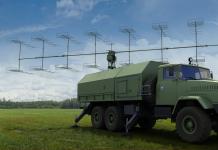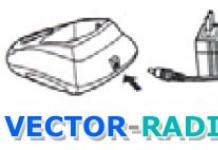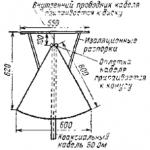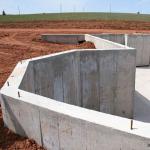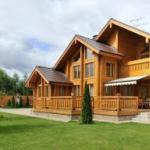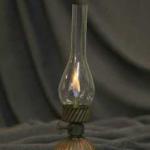The proposed antenna is a slightly shortened half-wave dipole with power in the middle, made of affordable materials, easy to manufacture and configure.
The antenna rolls up easily and can be quickly deployed in almost any environment. Such an antenna can be made for different bands, but it is especially advantageous to use it on the 27 MHz band.
Channel 19 is not for general conversations. That's essentially 80 channels. He then connected it to his antenna and power source and pressed the microphone. Apparently some of the circuits were tampered with internally, so now he has the problem of fixing the problem himself or paying for repairs.
This is just one of many examples, so be careful! More expensive radios may include a number of other controls that may or may not make much difference to individual users. Table below. This is a very dangerous practice due to the dangerous and corrosive chemicals contained in car batteries and the risk of releasing dangerous fumes.
The upper arm of the dipole (see figure) is made of stranded copper wire, and the outer surface of the section of the outer conductor (braid) of the coaxial feeder is used as the lower arm. This section is electrically separated from the rest of the feeder by a coil. The dipole arms are wave-shaped to match the 50-ohm feeder. This shape is maintained using a nylon line (or cord), to which the dipole conductors are attached at several points. The fishing line also serves to hang the antenna. The length of the free end of the fishing line and the length of the part of the feeder below the coil depend on the required height of the antenna suspension. The latter size should not be a multiple of half the wavelength; the best values are 2.6 m or 8 m.
They are widely available and relatively inexpensive. If you think you may need additional equipment and accessories in the future, then more expensive power supplies will be available that can provide the greater current that may be required.
A high quality 50 ohm coaxial cable should be used to connect the antenna to the radio. A higher quality cable has a denser, more effective braided shielding that minimizes signal loss and reduces the likelihood of interference.
A safe weight is tied to the end of the fishing line, which is thrown, for example, behind a dry tree, and then the antenna can be pulled up by the end of the fishing line. There should be as much free space around the antenna as possible. On a helicopter or hot air balloon, the antenna is simply hung down. There is no need for a counterweight or ground for the radio.
The coil is wound with the same continuous cable from which the lower arm of the dipole and the feeder are made. It should have an inductance of about 15 µH, it should be protected from water, snow, dirt, etc. getting between the turns. It is better to use a cable with a multi-core internal conductor, for example PK50-2-12 or RK50-2-16. For the upper arm of the dipole, you can use any insulated wire that more or less retains its shape when suspended. The number of “waves” of the wire in the arms of the dipole It is not critical. It is only important to maintain the total length of each arm (B and H) and the lengths of the arm wires indicated in the figure in brackets.
It has a half wave radiator section so it is a full size antenna. Not only is it a very effective antenna, but it is made from wire and is very light weight, making it easy to fix in different positions. a permanent antenna such as a silver rod and then creating a wire antenna that can be easily supported on a lightweight telescopic rod may be an ideal alternative.
So, to make a practical antenna. The sweet spot must be found through some experimentation - just like the best length for a wire radiator. The environment will affect the length of the radiator. This indicates the need to adjust the connection point of the coaxial cable to the 450 ladder line. The ladder line is used as an impedance transformer, converting the very high half wave emitter impedance to 50 ohms required by the radio and coaxial feeder cable.
To tune the antenna, it is convenient to use a multi-channel radio station, preferably with several grids (with a wider frequency range), and an SWR meter. By changing the size of the upper arm B (by uniformly stretching or compressing along the length of the line without changing the length of the wire), the dipole is tuned into resonance at the selected frequency, and then by changing the size of the lower arm H (without changing the length of the cable section in this arm), we achieve a minimum SWR at resonance. In this case, the resonance frequency may change, and the entire process may have to be repeated several times. After adjustment, firmly fasten the line to the wires of the arms to prevent displacement.
Thus, this connection point affects the impedance of the antenna, the higher the corresponding section, the higher the impedance, and vice versa. At this point, the coaxial cable braid is quickly soldered to the opposite side of the ladder line, ensuring that both points are equal in distance from the bottom. Once the ideal point is found, the coaxial cable can be properly and permanently soldered to the ladder line.
However, testing and setup took a little more time. Connection point = 5 centimeters from below. But any low loss 50 ohm coaxial cable can be used. The wire heatsink section is connected to the same ladder line conductor as the center conductor of the coaxial cable.
The authors manufactured according to the specified dimensions and tested two copies of the antenna with a coil on a polyethylene cylinder with a diameter of 60 mm and a length of 80 mm, containing 19 turns of cable, and with a coil on a ring 65x40x6 mm made of ferrite grade M55NN-1 - 22 turns of cable. The weight of the antenna without load is about 300 g. Both antennas have almost the same parameters. Using a panoramic SWR meter type R2-73, SWR values of no more than 1.5 in the 0.72 MHz band and no more than 2.0 in the 1.32 MHz band with a center frequency of 27.3 MHz were obtained.
For my antenna mounted on a fiberglass fishing pole, the radiator wire was 85 meters long. Once the antenna is completed and inspected and tested, all bare joints should be sealed against the weather using proprietary amalgamation tape or liquid electrical tape. The coaxial cable should also be secured to the ladder line using a nylon cable tie as a strain relief to prevent the weld joints from breaking.
The antenna consists of one vertical heatsink wire connected to the inner conductor of the coaxial cable, and three or four ground wires connected to the outer braid of the coaxial cable. Each wire is one quarter wavelength long.
The estimated 16 dB improvement in efficiency due to the transition from efficiency=2% helix antenna to efficiency=80% dipole is confirmed experimentally. On flat terrain, the additional effect of increasing the antenna elevation height from 1.5 to 5 m can give another 10 dB. The total gain of 26 dB is equivalent to a 400-fold increase in power, which allows the communication range to be increased by approximately 4.5 times.
Simply two quarter wavelength wires, one connected to the inner conductor and the other to the outer shield of the coaxial feeder cable. At this point, wrap about 10 turns of coaxial cable around a small piece of plastic water pipe to create a simple choke balun.
Short antenna for portable radio station
The mobile antenna should be placed in the middle of the vehicle's roof to make best use of the ground plane. The more you load the antenna, the shorter it is and the lower the radiation resistance. Lower radiation resistance means smaller signal output and input. Select the tallest antenna and place it as high as possible.
Antenna 144/430 MHz
The antenna is made in a plastic case (a telescopic rod made of fiberglass is very suitable), inside it is placed a sheet of pieces of copper wire connected to each other by coils L1, L2, L3 on plastic frames. A similar coil L4 is also located at the point of connection of the antenna sheet with the counterweights. The antenna is powered through a tuning capacitor C1 (with an air dielectric) to the second turn of coil L4 from the top.
The lower end of this coil is connected by counterweights to the cable screen. Pieces of foam rubber are put on the antenna canvas so that the whole thing does not dangle inside the plastic “fishing rod”.
Make sure each side of your coax cable feed lines is the same length, down to a fraction of an inch, but be sure to avoid the exact 11 meter half wave for your phased suspension. Install antennas on both sides of your vehicle. Best performance will be at the front and rear of the vehicle, with small zeros on each side of the vehicle.
Raise the whip as high as possible on your car. Why send half your signal into the sky when it can do more good near the horizon? You can easily locate these antennas with a disposable whip and a gray or stainless steel load coil at the base.
Element. Length
mm. Diameter
mm
H1 387 2.5
H2 424 2.5
H3 367 2.5
H4 564 2.5
H5 514 4.0* -
3 counterweights
Coil. Quantity
turns. Length
winding External
diameter Diameter
wires
L1 12.5 63 11.5 2.5
L2 64 280 11.0 1.5
L3 7 32 14.0 2.5
L4 6 18 13.0 1.5
DISCO CONE ANTENNA
Compared to a coaxial antenna, a disc-cone antenna, also having a circular radiation pattern and the same power supply method, has a significantly larger bandwidth. Compared to a conventional dipole, the gain of this antenna is -3dB. This reduction in gain should not be surprising since the disc-cone antenna has a correct radiation pattern over a very large bandwidth. The design of the disc-cone antenna shown in Fig. 11-40, subject to the specified dimensions and direct power supply via a coaxial cable with a characteristic impedance of 60 Ohms, has a passband from 85 to 500 MHz.
It stands about 20 inches tall with a sealed phased coil in the center and provides increased gain over the small 611 stud. A car with one roof mounted will generally still fit in a residential garage.
Due to this competitive market, companies are always trying to launch a better product at a lower price. However, you may want to try your hand at creating an antenna. The driven element receives transmission energy from the drilling rig. Rope, enough for the guy to be radial, depending on the height of the antenna.

The cone is made in the form of a horn from a sheet of copper or some other material that is easy to solder. The power cable is run inside the cone and its outer braid is soldered to the cone, and a cleaned section of the inner core 100 mm long is soldered to a metal disk. The disc is held horizontally
COLINEAR ANTENNA
Recently, the situation on the VHF amateur radio market has changed for the better for us radio amateurs. Today, an FM radio station on the 2-meter band has become available to everyone. In view of this, the question is which antenna to choose for a radio amateur who is mastering this interesting range for the first time? You can hear many answers, but today we will focus on an omnidirectional whip antenna, the appearance of which resembles the English letter J. This is an antenna for a beginner, for a summer residence, for local communications on VHF. 
We will not consider the operating principle of this antenna in detail. We will only note that the antenna is matched to the transmission line using a quarter-wave loop, which is equivalent to an inductor and capacitance.
Silicone sealant for covering the coaxial connection. The inner conductor of the coaxial cable is connected to the aluminum pipe using a screw at the bottom of the pipe. Detailed drawing on this page. Coat this joint with caulk or tape to protect it from corrosion. All vertical antennas must be grounded in some way. This is called the antenna ground plane.
The braided wire that forms the outer conductor of the coaxial cable is soldered to all four radial wires. Remember that the inner conductor and outer braid of the coaxial cable must not touch each other and the rays must not touch the driven element. The radionates are tilted downwards at 45 degree angles in different directions and are tied to insulators. Rope or nylon cord is then tied to the insulators and used to hold the radii. They can be attached in any convenient place; trees, fence, house, etc.
Using the formulas given in Figure 1, we obtain the antenna dimensions A, B, C and D.
For frequency 145.5 MHz:
A = 148.29 (cm)
B = 49.19 (cm)
C = 4.63 (cm) (for Rfeeder=50 Ohm)
Material - copper or aluminum, tube or wire. Whatever is at hand. I used round aluminum wire with a diameter of 9 mm. The only thing you need to remember is the shortening coefficient k, which relates the electrical length of the antenna web to its geometric length. The thicker the conductor, the greater this difference. In order not to make a mistake with the antenna length, it is recommended to make size B a little larger, and then bite off the excess during the setup process.
It should be below 2 and ideally below 5 or. We talked to stations within a 40 mile radius using this antenna, which was about 30 feet high, using a mobile base rig. After removing the outer jacket, begin grouping the shield down with the coaxial cable at the end. Now that the outer jacket and shield are matched, separate the shield braid to expose the inner conductor through the hole in the braid. Pull the entire inner conductor and pull it and the braid out. Be careful not to insulate the housing from the inner conductor.
The antenna was tuned using an SWR meter or field indicator.
We attach the central core of the cable on crocodiles to the long element (A), and the braid to the short one (B). And we begin to alternately switch on transmission, looking at the SWR meter and moving the crocodiles, achieving a minimum SWR at the operating frequency. We turned it on, looked at the SWR meter, turned it off, and moved the crocodiles. There should be a minimum SWR in the area of 4-6 centimeters from the jumper. If you can’t achieve an SWR close to 1.1-1.2, then you should play around with length B, biting off a few millimeters at a time. During measurements, it is recommended to place the antenna between two backs of chairs, away from the floor, surrounding objects, and especially metal.
Now attach the antenna insulator to the end of the inner conductor. Cut it to about 106 inches and attach the antenna insulator to the end. The total length of the inner and outer conductors should be approximately 17 feet. You can raise it to any height you want using a cord or rope attached to the insulator on the center conductor. It is a good idea to coat the end of the coaxial cable where it separates with some kind of waterproof sealant.
Simply attach the coaxial connector on the end of the coaxial cable to the transceiver and you're on the air. The metal pipe serves as a ground connection for the antenna, replacing the vehicle body. Be sure to run a separate ground wire to a proper ground rod for lightning protection.
After setting, clamp the cable onto the bolts with clamps, check if the setting is wrong, and then seal the contacts with automotive sealant.
Below a few centimeters from the connection point, it is recommended to wind a filter, which is 4-5 turns of the same cable on a frame, for example, from a 10 cc syringe. As a result, the flow of RF currents onto the cable braid will be reduced and the possible TV interference will be reduced.
This is a simple antenna to assemble and find parts. You can use any number of pieces of aluminum pipe as long as they are cut and thick enough to not bend or break in high winds. The pieces should be gradually smaller, one of them can fit into the next. Use a hacksaw to cut two 2-inch grooves into the outer pieces of aluminum and place a hose clamp around them. Now adjust the antenna to 22 ½ feet and tighten the hose clamps to hold it all together.
This board should be treated or painted to protect it from the elements. Place a bolt through a piece of wood a few inches below the vertical piece. Here you must secure one end of a 6-foot piece of copper wire or tubing, the outer braid of the coaxial cable, and each of the 104-inch stranded wires. These are called ground radions and must be tied with a cord at a 45 degree angle from the bolt. The radials and braided coax can be soldered together or can be crimped together with a crimp connector that fits onto the bolt.
Any 50 ohm cable can be used. In my case, this is a small piece of 3-4 meters of thin RG-58U from the antenna connection point to the balcony, and then through the connector about 25 meters of thick RG-8. I note that the thicker the cable, the lower its attenuation coefficient, as a rule. The thinner, the greater the loss of the useful signal. The same applies to the length of the cable; the longer the cable from the antenna to the transceiver, the greater the loss of the useful signal. In other words, to reduce losses in the cable, we try to adhere to the rule “the thicker and shorter the cable, the better.”
The other end of the 6-inch copper wire is bent and secured to the vertical member. The center wire end of the coaxial cable is then twisted so that it slides up or down along the copper wire and is soldered once adjusted. Be sure to completely seal the end of the coaxial cable with sealant to prevent moisture from getting into it.
While the following project won't necessarily save you any money, you might want to give it a try if you're interested in learning more about how fiberglass antennas are sold. Two plastic insulating washers. First, you should get yourself a fishing rod that is 6 to 9 feet long. If you already have an old one lying around, you can press out the loops of the line and cut out the handle.
It is recommended for repetition by beginning VHF players, as well as as a review or backup antenna for experienced VHF radio amateurs.
Literature.
1. Karl Rothhammel: Antennas. Volume 2. Edition 11. Publishing house Light LTD., 2007, p. 10
Short antenna for portable radio station
Igor, UA6HJQ
(August 2001)
All portable radios are sold complete with standard shortened antennas, which are popularly called “rubber bands”. Some “elastic bands” are quite long and if you don’t need to tie over long distances, they just get in the way. I decided to make an even shorter antenna, convenient for everyday use and short-distance communication.
Range 144 - 146 MHz

... for Yaesu VX-1R and C-508
I made this antenna for the VX-1R because it has a small SMA type antenna connector. The total length of the antenna with connector is 43mm. A wire with a diameter of 0.6 mm is wound turn to turn on a frame with a diameter of 8 mm. A total of 25.5 turns were wound. In this case, resonance was obtained at a frequency of 145.3 MHz and SWR 1.1. After winding and checking the resonance, a thermal tube is placed on the antenna and heated. Thermal shrinkage tightly fits the antenna and gives it a “signature” look.
For any r/stations with SR-50 connector
The total length of the antenna including the CP-50 connector was 69mm. A wire with a diameter of 1.3 mm is wound turn to turn on a frame with a diameter of 10 mm. A total of 22 turns are wound. In this case, resonance was obtained at a frequency of 145.3 MHz and SWR 1.1. After winding and checking the resonance, a thermal tube is placed on the antenna and heated.
Range 430 - 440 MHz  The design of the antenna for the 433 MHz band does not differ from the previous design, only the number of coil turns must be reduced. The total length of the antenna including the connector is 42mm. A wire with a diameter of 1.3 mm is wound turn to turn on a frame with a diameter of 8.5 mm. A total of 6 turns are wound. The resonance was obtained at a frequency of 435.3 MHz and SWR 1.8. After winding and checking resonance,
The design of the antenna for the 433 MHz band does not differ from the previous design, only the number of coil turns must be reduced. The total length of the antenna including the connector is 42mm. A wire with a diameter of 1.3 mm is wound turn to turn on a frame with a diameter of 8.5 mm. A total of 6 turns are wound. The resonance was obtained at a frequency of 435.3 MHz and SWR 1.8. After winding and checking resonance,
Very often now you can see on the Internet advertisements for the sale of standard antennas for portable radio stations on 2m and 70cm. The prices of these “rubber bands” are very inflated and sometimes it really hits your pocket for such a small thing.” Therefore, having asked the question HOW TO MAKE AN ANTENNA FOR A PORTABLE, I found an interesting one in also a simple diagram.
 The antenna operates on the 2m and 70cm bands. Good luck in radio sports!!
The antenna operates on the 2m and 70cm bands. Good luck in radio sports!!
CB radios are often used in the country and in the field. Moreover, sometimes a C-B radio station is purchased only to ensure communication with a dacha, a fishing spot or on a hiking trip. Since the physical dimensions of C-B antennas in the 27-MHz range are relatively small, then, as a rule, in the dacha and in the field conditions there are no problems with installing a full-size antenna.
The main criterion that must be taken into account in this case is the ease of installation of the antenna, and the purposes for which the antenna will be intended. Now let's move on to consider the practical designs of these antennas.
A simple country quarter-wave vertical CB antenna of the 27 MHz range. In my opinion, the optimal antenna that can be installed in a dacha is a quarter-wave vertical. This antenna has many advantages over other types.
It emits radio waves that are predominantly vertically polarized, which is optimal for communication with car and portable radio stations in the 27-MHz C-B range.
The vertical polarization radiation pattern of a vertical whip antenna is circular, so it will be able to provide radio communications in all directions, which is often required of it. For example, Provide radio communication with the city, with the highway along which the car approaches the dacha, with a fishing or hunting place.
Rice. 1 shows a diagram of a quarter-wave vertical antenna of the Si-Bi range. Let's take a closer look at the design of this antenna. It consists of a lambda/4 electrical length pin connected to the central core of the coaxial cable and four counterweights. The pin can be 5-40 mm in diameter, the exact length for several pin diameters is indicated in this figure.
To make it, it is convenient to use an aluminum or copper tube. For example, two ski poles that have reliable electrical contact with each other work well with copper water pipes, which have recently appeared on the market.
Fig.1. 27 MHz antenna design.
The counterweights can be positioned to the antenna pin at an angle of 90 to 140 degrees. Depending on the angle at which the counterweights are located to the antenna, the input impedance of the antenna depends.
A quarter-wave whip antenna, installed at a height of at least 0.3L relative to the ground surface and equipped with four quarter-wave counterweights, has an input impedance of about 20 ohms when the counterweights are located at an angle of 90 degrees to the antenna. The antenna resistance increases to 40 Ohms when the counterweights are located at an angle of 120 degrees to the antenna, and to 50 Ohms when the counterweights are located at an angle of 135 degrees to the antenna (see L.1).
Of course, it is preferable to use counterweights located at an angle of 135 degrees to the antenna pin, in which case the antenna has an input impedance of 50 ohms, which optimally matches the coaxial cable with a characteristic impedance of 50 ohms.
Increasing the antenna installation height has little effect on the nature of the antenna input impedance. Reducing the antenna installation height causes an increase in input impedance.
This occurs due to the absorption of the reactive field existing near the antenna by the real earth. As a result, the transmitter energy is spent on heating the earth and is not used for radio communication. Low installation of the vertical antenna should be avoided; otherwise, in order to maintain operational efficiency, the number of antenna counterweights should be increased to several dozen (L.2).
At the end of the coaxial cable, it is advisable to install a high-frequency choke (also called a blocking choke), which will prevent high-frequency current from flowing into the outer sheath of the cable. This may happen if, for some reason, the resistance of the outer sheath of the coaxial cable is comparable to the resistance of the counterweights.
In this case, the outer sheath of the cable will serve as the radiating part of the antenna, which will lead to an increase in the level of interference when the antenna operates for transmission and loss of high-frequency energy in objects surrounding the coaxial cable. The simplest design of a blocking choke is 10-30 ferrite rings tightly placed on the end of a coaxial cable; the permeability of the rings does not matter.
Instead of ferrite rings, you can use ferrite tubes, which are installed on the cords of computer monitors. When installing ferrite rings on a coaxial cable, the resistance of the area where the ferrite rings are installed for high-frequency currents increases significantly, as a result of which high-frequency current from the coaxial cable will flow into the antenna elements rather than into the outer shell of the coaxial cable.
Rice. 2 shows a graph of the input impedance of the antenna shown in Fig. 1. Fig. 3 shows the SWR of this antenna in relation to a coaxial cable with a characteristic impedance of 50 Ohms, and Fig. 4 shows the vertical polarization radiation pattern of this antenna.
The MMANA program shows the antenna radiation pattern in the horizontal plane as a section of the volumetric diagram with X-Y planes along the angle of maximum radiation. In the vertical plane, the antenna's radiation pattern is a cross-section by the X-Z plane of its volumetric radiation pattern.
On fig. 1, which shows a vertical antenna, shows the location of these section planes. In the calculations, it was assumed that this antenna is located at a height of 3 meters above the real ground (conductivity is 5 mS/m, dielectric constant e = 13). These graphs were calculated using the MMANA program (see L.2).
In all cases of calculation, it was assumed that the diameter of the pin is 20 mm, the diameter of the counterweights is 4 mm, and the antenna is made of copper.
Tab. 1 shows the length of the pole of a vertical antenna mounted 3 meters above the real ground, and equipped with four counterweights 270 cm long, located at an angle of 135 degrees to the antenna pole, at which it resonates at a frequency of 27 MHz.


Please note that changing the height of the antenna, the number of counterweights, and their angle of inclination leads to a change in the resonant frequency of the antenna. The resonant frequency of the antenna will decrease if you use a pin or counterweights in plastic insulation (see L.1).
The antenna can be tuned to the resonant frequency by lengthening/shortening the antenna pin (some methods for lengthening/shortening the antenna pin are given in L.2), as well as antenna counterweights. Adjustment of the antenna input impedance can be done by changing the angle of inclination of the counterweights relative to the antenna pin.
As can be seen from Fig. 3, with SWR in a coaxial cable with a characteristic impedance of 50 Ohms
A further increase in the diameter of the pin leads to an expansion of the antenna's bandwidth, and a decrease in the diameter of the pin leads to a narrowing of the antenna's bandwidth.

Fig.4. Directional pattern of a homemade 27 MHz antenna in vertical polarization.
Rice. Figure 5 shows the dependence of the bandwidth of the antenna described above (a rod with a length corresponding to Table 1, 4 counterweights with a diameter of 4 mm located at an angle of 135 degrees to the rod, an installation height above the real ground of 3 meters) for an SWR value in a coaxial cable equal to 1.5: 1 and 2:1.
As can be seen from this figure, even a “thin” antenna with a vibrator 5 mm thick will provide acceptable operation on the 27-MHz C-B band, especially if you are guided by the SWR in the coaxial cable of the antenna equal to 2: 1, and this is precisely the value The SWR is quite consistent with 99% of commercial CB transceivers.
It is quite possible to manufacture a vertical antenna with a pin consisting of vibrators of different thicknesses, for example, from a ski pole with a diameter of 16 mm and a length of 1.5 meters and a piece of wire from a power transmission line with a thickness of 4-6 mm and an approximate length of 1.2 meters. The MMANA program allows you to calculate the parameters of such so-called “tapered” antennas.
The English word (in this case, it would be more accurate to say the American) “tap” can be translated here as “part of an antenna of a different diameter.” In the case of such a combined antenna, it is necessary to use a design that ensures reliable electrical contact between sections. For example, in this case, a vibrator of a smaller diameter is riveted into a vibrator of a larger diameter, a vibrator of a smaller diameter is tightly screwed to a vibrator of a larger diameter, or a transition insert is used between vibrators of different diameters.
To install a vertical whip antenna, you can use natural or artificial elevations. For example, you can use a dry tree or a roof ridge as a mast.


Fig.6. Installation of a homemade 27 MHz antenna on the roof ridge.
When installing the antenna on the roof ridge, make sure that there are no objects under the antenna that absorb high-frequency energy. Installation of the antenna on the ridge of the roof of the cottage is shown in Fig. 6.
To attach the antenna pin as a homemade support insulator, you can use a strong, dry wooden stick, preferably oak, which must first be boiled in paraffin. This will give this surrogate support insulator electrical strength, insensitivity to moisture and protection from rotting. The antenna is attached to a wooden stick with two long screws; in extreme cases, it is simply screwed with a thick wire.
Instead of a wooden stick, you can successfully use pieces of plastic water pipes or a plastic ski pole. Instead of these surrogate support insulators, it is quite possible to use commercial support insulators, or support insulators used for installing VHF intercom antennas. Support insulators from old decommissioned VHF antennas can be purchased inexpensively on the radio market.
Pay serious attention to the installation height of the antenna. The minimum acceptable height for the C-B range can be considered 0.25 * lambda, or 2.75 meters. In this case, the height is measured from the base of the antenna.
As the height of the antenna decreases, the ground begins to absorb high-frequency energy that is created around the counterweights and under the base of the antenna when the antenna is operating. In practice, this will be expressed in a drop in antenna gain and in a decrease in radiation at small angles to the horizon, which is exactly what is required for both low-level (local) and long-distance communications on the CB. The antenna counterweights will no longer have resonance on the 27 MHz band, and the antenna will need to be tuned only by changing the length of the vibrator.
It is possible to eliminate the effect of loss of antenna gain and increase radiation at lower angles to the horizon by increasing the number of counterweights, and in order for the antenna to work sufficiently efficiently, the number of its counterweights can be in the dozens (more information about the number of counterweights of an antenna located on the ground can be read in L.2). However, in my opinion, on the 27 MHz band it is easier to use an elevated whip antenna with 2-4 counterweights than to install dozens of non-resonant counterweights around a antenna standing on the ground.
To power the quarter-wave vertical antenna shown in Fig. 1, a coaxial cable with a characteristic impedance of 50 ohms is required. It is desirable that the electrical length of this cable be a multiple of half the CB wavelength of the 27 MHz range; this will immediately eliminate many problems that arise during setup and operation of the antenna.
As mentioned earlier, the input impedance of a quarter-wave vertical antenna depends on many factors, and in practice it can be in the range of 30-70 ohms for an amateur radio vertical quarter-wave antenna installed on a roof ridge. Using a half-wave section of coaxial cable to power the antenna will allow you to “deliver” the input impedance of the antenna without unnecessary transformation directly to the output stage of the transceiver, which, in general, will somewhat increase the efficiency of this antenna-feeder system.
For a cable with polyethylene insulation, the length of the half-wave segment will be 3.63 meters, and for a cable with fluoroplastic insulation, 4.4 meters. It is necessary to pay serious attention to protecting the opening of the coaxial cable from atmospheric influences. The easiest protection can be achieved using fast-hardening automotive epoxy putty.
More details about vertical antennas can be read in L.Z and L.4.
A whip antenna installed in a rural area high above the ground, even a small one designed for the 27-MHz CB band, needs protection from atmospheric electricity. Otherwise, the transceiver connected to this antenna may be damaged and the operator may receive electric shock. Some methods of protecting antennas from atmospheric electricity are described in L.2 and L.Z.
Grigorov I.N. RK2005, 2.
Literature:
- Grigorov I.N. Antennas. Urban structures. - M.: IP RadioSoft, 2003.
- Grigorov I.N. Antennas. Configuration and coordination. - M.: IP RadioSoft, 2002.
- Grigorov I.N. Practical antenna designs. -M..DMK, 2000.
- The ARRL Antenna Book. 20-Edinion: published by ARRL, USA, 2003.
The authorship of the antenna design belongs to RX3AKT. In essence, this antenna is a half-wave vibrator powered from the end and matched with a cable loop. In terms of efficiency, such a coaxial antenna is not much inferior to factory analogues from the same Sirio, and is much simpler and more compact to manufacture. The antenna was conceived as a traveling option, since it is very light and compact, but it can also be used stationary.
For manufacturing you will need 7 meters of RG-58 cable (antenna fabric + matching part), a piece of RG-58 cable of arbitrary length to connect the antenna to the walkie-talkie, a PL-259 or SO-239 connector, a few centimeters of heat shrink of a suitable diameter (for example 7mm and 12mm), instant glue, a sharp knife, a soldering iron with solder and rosin, and 40 minutes of free time. For modeling, I recommend using the crappiest cable on the market, namely REXANT. These guys make great solder and other radio mounting stuff, but their cable is truly terrible, but it is cheap and can be used for antenna building experiments.
The antenna consists of 3 parts. The part is 520 cm long; this antenna sheet is the radiating part. The part 152 cm long is the matching part, it represents a capacitance, the part 23-24 cm long also belongs to the matching part and represents inductance. During the assembly process, it is easiest to use the image from the title of the article. The points in the figure are solder joints.
1. Take the RG-58 cable and cut a piece 7 meters long.  2. Strip the braid on the cable from both ends, approximately 1-1.5 cm.
2. Strip the braid on the cable from both ends, approximately 1-1.5 cm.  3. Remove the foil, if any, and twist the central core with the cable screen.
3. Remove the foil, if any, and twist the central core with the cable screen.  4. Carefully solder the twist of the central core and screen.
4. Carefully solder the twist of the central core and screen.  5. Next, measure 23 cm from one of the ends of the cable and make a cut in the cable braid, but so as not to damage the screen. We retreat another 2 centimeters (25cm) from the cut and make another cut. Our task is to remove the PVC cable braid without damaging what is underneath it.
5. Next, measure 23 cm from one of the ends of the cable and make a cut in the cable braid, but so as not to damage the screen. We retreat another 2 centimeters (25cm) from the cut and make another cut. Our task is to remove the PVC cable braid without damaging what is underneath it.
 We remove the braid and foil, and move the screen to one side and cut it in half. Let's leave it alone for now, we'll come back to this later.
We remove the braid and foil, and move the screen to one side and cut it in half. Let's leave it alone for now, we'll come back to this later.
 6. We measure 152 cm from the area with the braid removed, and just as in point 5, cut off a part of the braid about 1.5-2 cm wide from the cable. After this, cut the screen from the short part (23 cm + 152 cm) so that on the short part the screen protruded beyond the braid minimally. Remove the foil.
6. We measure 152 cm from the area with the braid removed, and just as in point 5, cut off a part of the braid about 1.5-2 cm wide from the cable. After this, cut the screen from the short part (23 cm + 152 cm) so that on the short part the screen protruded beyond the braid minimally. Remove the foil.  7. Using a sharp knife, remove half of the polyethylene protecting the central core, so as not to damage it and not completely cut the fabric in half. We tin the central core and the screen and solder them to each other.
7. Using a sharp knife, remove half of the polyethylene protecting the central core, so as not to damage it and not completely cut the fabric in half. We tin the central core and the screen and solder them to each other.  8. After the soldering area has cooled and the polyethylene has hardened, you need to seal the connection. To do this we use Moment glue. Apply it liberally, especially to the soldering area and the cut ends of the braid. Without fanaticism. Be sure to let the glue dry a little and only then move on to the next step.
8. After the soldering area has cooled and the polyethylene has hardened, you need to seal the connection. To do this we use Moment glue. Apply it liberally, especially to the soldering area and the cut ends of the braid. Without fanaticism. Be sure to let the glue dry a little and only then move on to the next step.  9. We put a heat-shrinkable tube with a diameter of 6-7 mm on top and shrink it (best by heating it with a hairdryer). On top, you can apply another layer of heat shrink, so to speak, for strength and greater length. After the glue cools and dries, a completely strong and airtight connection is obtained.
9. We put a heat-shrinkable tube with a diameter of 6-7 mm on top and shrink it (best by heating it with a hairdryer). On top, you can apply another layer of heat shrink, so to speak, for strength and greater length. After the glue cools and dries, a completely strong and airtight connection is obtained.  10. Return to the 23 cm piece. Similarly to point 7, remove the layer of polyethylene up to the central core and solder the reduction cable. It must first be cleaned, as in point 2. Solder the central core of the reduction cable to the central core at the point 24 cm.
10. Return to the 23 cm piece. Similarly to point 7, remove the layer of polyethylene up to the central core and solder the reduction cable. It must first be cleaned, as in point 2. Solder the central core of the reduction cable to the central core at the point 24 cm.  11. We put heat shrink with a diameter of 8-10 mm on top and place it on both central cores.
11. We put heat shrink with a diameter of 8-10 mm on top and place it on both central cores.  12. We solder the screens of part of the 23 cm cable, part of the 152 cm cable and the reduction cable at one point.
12. We solder the screens of part of the 23 cm cable, part of the 152 cm cable and the reduction cable at one point.  13. Coat the soldering area generously with glue, let it dry and put heat shrink with a diameter of 12mm on top. We sit down.
13. Coat the soldering area generously with glue, let it dry and put heat shrink with a diameter of 12mm on top. We sit down.  14. On the ends of the antenna (23 cm and the radiating part), also coated with moment, we put trem-shrink on it and seat and seal the ends.
14. On the ends of the antenna (23 cm and the radiating part), also coated with moment, we put trem-shrink on it and seat and seal the ends.  15. Solder the connector for the radio station to the end of the reduction cable and... Done.
15. Solder the connector for the radio station to the end of the reduction cable and... Done.
On the pages of this catalog you will find antennas for car CB radios, suitable for different situations and radios, located in different price categories and having different characteristics from each other.
To make the right choice, read product descriptions. If you have any additional questions, our consulting engineer will be happy to answer them.
Here are just a couple of examples of what differences you can get that are beneficial to you (take different manufacturers):
- Alan 9 Plus. This antenna is a cut-in type (a small hole is drilled in the housing for installation). Its operating frequencies are 25-30 MHz, it has 200 channels, a gain of 4 dB and a maximum power of 300 W. The length of the pin is 155 cm, the pin is made of stainless steel;
- MegaJet ML-145 MAG-160. This antenna is already attached to a magnetic base. Its frequency range is 26.9-27.5 MHz, the number of channels for operation has been increased - 120, but the height of the pin has been reduced - 142 cm. The antenna has the same power (300 W), although its peak power can reach 900 W;
- Optim CB-2001. This antenna is intended, rather, for vans and trucks: its length is 2 meters, it has an unshakable mortise mount, and the maximum input power is 2000 W.
You can find out additional characteristics of the antennas by following the appropriate links to the product pages. Please note that the catalog contains antennas for discontinued or obsolete radios.
We'll be happy to answer any questions about civilian radio antennas. Call!
Pokhodnayamobile antenna "STERKH"
for CB-band (27 MHz)
Idea
After our vigorous experiments with portable and basic antennas, the task arose to create something in between in terms of efficiency. A portable 40 cm pin has a good performance limit of up to 7-8 km. Carrying a second Owl with you through the forest is hardly convenient, and deploying it in a desert area without a mast is generally unrealistic. In addition, not all “dummies” can handle an oar to solder a control system correctly.
I wanted to make the antenna as simple as possible, from a couple of wires, and I calculated the Zabredun dipole, from which I intended to dance. However, it turned out to be worse than thought: narrowband, with SWR on the verge of good, and negative gain. Most likely, the dipole was considered in MMANA , which does not know how to work with low-mounted antennas and overestimates dbi . In addition, the radiation goes mainly upward!...
The same garbage as the first version of “Owl”. If you calculate the antenna taking into account the thinnest insulation, the SWR will become completely sour... That is, this dipole, of course, is better than a standard rod, but only due to the height of the suspension and the length of the blades. Take a look at the results:
Z =78.417 + j 64.474 SWR (50+ j 0)= 2.92
Max Gain : -1.02 dBi at azimuth : 222 deg
Max Gain: -0.12 dBi at elevation 79 deg
To be fair: on the test, the dipole showed an SWR of about 2. But this design is still not suitable for us, like everyone elsecommon “forest” analogues of radio amateurs - dipoles, beams, inverted V, classic GP and so on. – they are either outrageously long, or “shoot” upward, or require at least one suspension point, and quite a high one at that.Making a mini-analogue of the “Owl” is also a bad idea, the matching device will kill the entire efficiency of the antenna. And in general, the “owl” place is at the base! Place it and smoke bamboo. A group or person leaving the camp will want to take something more convenient with them in the sweep (RU3DKW considered the option of a plumb bob with a capacitive load, but did not get to the point of specific modeling, although we may still be thinking about this option).
In short, the new antenna must be portable enough to be worn, and at the same time not much inferior in efficiency to the Sova, and most importantly, it must be deployed by one person on any terrain and cover at least 15 km with a “good” rating.
Sergei turned out to be very busy, so I had to think through the geometry, material, and study the necessary programs myself; after which I modeled and calculated a structure vaguely reminiscent of a paper crane. So, our “birds” have arrived in the regiment!...
Theory
USTERKHA rigid vibrator made of duralumin tubes, bent at the top at a right angle, and two counterweights:
The antenna has a simple geometry, no matching device, no soldering, and no feeder. The most difficult thing here is to fuse the lower tube and BNC -mom. The tubes must fit tightly into each other, be even at the joints and smooth. The most complex element is a pipe bent 90 degrees.
The antenna has V -polarization and good bandwidth (~1460 kHz at SWR<=1,5 и ~2890 <=2.0). СТЕРХ рассчитывался условно на середине СиБи диапазона (27,605 мгц), с реальной землей средней плешивости.
The antenna turned out to be directional and has a gain** ~1.5 Dbi at a small angle to the horizon, which is very good for such a small and mundane structure. The direction of STERKH radiation is concentrated from the center of the open corner of the counterweights. You must use counterbalances to take the correspondent “in pincers.” Considering that the angle is quite wide, it can be conditionally directed towards the side of the world where the interlocutor is located.
In the classic case, the vertical part of the vibrator is built as 210 cm, and the “beak” = 40 cm. In this case, the counterweights = 282-286 cm, and their lower ends should be ~30-40 cm above the ground. The length of the “beak” can vary from 24 to 40 cm, without affecting the matching, but the total length of the antenna must remain 250 cm.
As you can see, the petal of the diagram is well pressed to the horizon, which cannot but please the eye. C with any insulated wire, the antenna has an SWR of no more than 1.2 (in all programs). Considering that the STERKH counterweights are insulated, the first dimensions had to be adjusted taking into account the radii of the “skins,” but I was satisfied with the results:
Vibrator – made from duralumin tubes with a diameter 6 mm (wall thickness 0.6) and is divided into segments. A larger number of segments is dictated solely by the portability of the antenna.
The tubes fit into each other according to the principle of tent poles; inside the vibrator there is a 2 mm elastic band, which is sold in any fishing store. The lowest tube is rigidly fixed in the wiring box, into which it is screwed BNC - connector, or in another way,
The lowest point of the vibrator should be located 160-170 cm from the ground (theoretically, this is the height of the connector of the walkie-talkie, which an adult holds in his hand during a conversation). The position of the "beak" does not matter.
When using a tube with a cross-section 10 mm the gain above the horizon will reach ~2 decibels. When using hardware, the bandwidth increases, but the matching deteriorates (the dimensions must be adjusted) and decreases dbi (almost twice). In addition, the vibrator becomes heavier, so you should not use stainless steel.
Counterweights - you can use any insulated copper wire 0.5-1.5 mm in diameter. They must be attached with a clamp or soldered to the ground of the antenna connector.
When purchasing a silicone audio cable, you should pay attention to one whose “skin” thickness is no greater than the diameter of the core, and, preferably, round in shape. The thick “peel” can suppress up to half a decibel, which we already have in short supply...
The counterweights must be positioned exactly 90 degrees relative to each other. A slight narrowing of the angle is allowed, but not widening! The bottom end of each counterweight must be in ~ 30 cm from the ground, and the top one - 160-170 cm. The ideal angle of plumb lines relative to the ground is 45 degrees.
Stretching the plumb lines lies entirely with the operator, since the top attachment point is the walkie-talkie, which he holds in his hand. Plumb lines actively participate in the diagram and should not sag or be incorrectly positioned in space.
In order to properly stretch the counterweights, first spread them at right angles on the ground, stick in the pegs, and then lift the radio and pull it. At the end of each counterweight it is necessary to make a rope guy, and at its end - a loop for a peg.
Naturally, both counterweights must be made of the same wires and be the same length. It is advisable to avoid breaks and soldering - for STERKh these are radiating elements.
Construction
Nikolai from FMK*** made two sets of pipes in a few hours, fortunately they have everything: pipes, machines and extensive experience in working with aluminum. Unfortunately, the 6 mm pipe is too thin to work with bushings, and it had to be bored out to fit the “neighbor”, so several unplanned thickenings appeared on the vibrator at the joints.
An example of a camping kit:
Vertical part: 10+40+40+40+40+ 40 cm + 6 cm bent pipe = 216 cm
Horizontal part: 34 cm of bent pipe (“beak”).
216+34= 250 cm total length. When making pipes, remember that each joint “eats” 2 cm! Therefore, each tube should be made 2 cm longer.
There are different ways to attach a vibrator to a walkie-talkie. I decided to attach it to the “legs” of old 50-ohm “telescopes” that were lying around the house without use. This is not difficult to do, since the copper wire from the coil is already soldered in, all that remains is to cut off the required piece, clean it with a file and screw it onto the tube. A small groove was machined into the aluminum for this purpose:
Don't forget about the problem of contact between different metals. If you simply solder or wind a copper wire from the connector core onto an aluminum pipe (as I did for the test), after a while we can have a war of antagonists in the form of oxide, and, as a result, non-contact. Therefore, it is better to connect them through an iron “intermediary” in the form of a self-tapping screw or something else.
And now the first STERKH is ready!
STERKH folded next to the Berkut
This is what STERKH looks like on “Alan”:
I designed two antennas, with different thicknesses of counterweights (in silicone), one of which was sent to the Pushkinsky district for a joint test.
Let's consider “my” option with counterweights with a copper core cross-section 0,75 mm and length 282 cm each. Vibrator height = 216 cm, beak length = 34 cm. Length of counterweight ropes = 95 cm .
Measurements on the street with radio stations "Berkut-803A" and "601m2T" showed that the calculation of partsturned out to be correct:
Real SWR indicators at frequencies 28 805-705: B601 = 1.1, at B803 = 1.2. You can't drink away mastery!… J The design hit the spot.
The height of the suspension of the lower ends of the plumb lines during the measurement was about 30 cm, and the height of the antenna suspension (in fact, eye level) ranged from 160 to 170 cm from the ground, while the SWR remained stable.
Tests
A strong snowstorm during testing has already become a good tradition. But the angrier you are in training, the easier it is for the birds in battle!… J
Chil and Seryoga crawled out into their yard in Pravda, and I, as usual, crawled onto the Mytishchi field, about a hundred meters from the house, I turned the “Owl” around in the snowdrifts and prepared the STERKH. The initial plan was this: if we don’t break the initial 20 km between two STERKHs, then the guys get into the car and shorten the distance until the signal appears.
However, the very first connection between the Siberian Cranes showed an almost perfect connection = 5.8 –5.9! Moreover, “Owl” was heard a little “worse”. Either the polarizations of the fry did not match, or the gain of the new antenna beat even the five-meter vibrator of a competitor, whose gain is close to zero, by the way.
Inspired by the results, the men drove another 8 km, and then another 2. The road wanders a lot into the forest, so there is enough vegetation.
In total, the maximum distance for that day was exactly 30 km (point at GPS between Balabanovo and Khlopenevo). Not enough, but I got stiff in the wind and the test was stopped. In terms of signal strength, STERKH has a power reserve for a longer distance (minimum 40 km).
The connection was mainly 5.7-5.8-5.9. Sometimes (after 20 km) it dropped to 4.8. Very strong interference in my area. For this reason, Pravda always heard me a point better than I heard them. However, the signal is good and clear, intelligibility is almost 100%.
I worked at 6 and 5 watts. At 28 km, the guys connected the B601m2 on batteries (2 watts), and I heard them normally, although the signal became worse (4.7) - I had to listen through the interference. Total: it is clear that after 20 km, radios with 4 or more watts rule, but communication with a low-power one is also possible. The problem was mainly in the strong QRM , if it weren’t for the interference, the two-watt connection, even at long distances, would be 4.9, at least. We can conclude that in places with clear air, the antenna will work well with any power. And the weak signals of STERKH, according to Chila, “pressure”, so a distant dispatcher somewhere on the Kola will not interfere with conversations. Despite the terrible on-air noise, STERKH allowed us to conduct a test on only two channels, which once again confirms the thesis: happiness is not in the number of channels, but in the efficiency of the antenna. J
Since I was unable to take a photograph of myself, I am attaching a drawing of a fictitious man. Here's how it all looks schematically (the antenna is pointed at the correspondent - at you):
Results
STERkh belongs to the class of “mobile” antennas I invented - something between a basic and portable antenna for hiking communications. Gain in the direction of the correspondent ~ 1.5 decibels. Great job at the intersection. The operating range of STERKH is determined by the landscape and in clear air conditions it can, I think, reach 50 km.
What do we have compared to Owl-2?
Pros:
1. No complex matching device
2. No need for suspension points: trees, masts, sticks, etc.
3. Availability of real gain at low vibrator height
4. No need for local adjustments: SWR will not go beyond 1.5 anywhere
Minuses:
1. Antenna directivity. Still, you need to turn her “facing” the correspondent, at least conditionally
2. Manufacturing of tubes (needs machines, etc.***)
3. Tubes are more susceptible to breakage than soft wire
Despite the fact that the tubes are more difficult to make, a hard vibrator distinguishes the antenna from its “soft” counterparts - it can be used on flat terrain and without having to run around looking for trees, which, by the way, like to bend the diagram and spoil the matching. Now any landscape: desert, steppe, tundra, bald foothills - everything is in our hands! J
The thickening at the joints did not affect the efficiency of the antenna, so you can use this vibrator manufacturing scheme, but it is necessary to seal the joints - this is a clear disadvantage for the test version.
Rubber , stretched inside the tubes, ensures almost lightning-fast assembly of the vibrator. Stretching two counterweights, I think, will also not cause any particular difficulties. STERH easily fits into a deep jacket pocket. Damaged counterweights, if something happens, can be easily replaced with new ones - the wires are simply attached with a clamp to the connector leg. A broken segment can also be healed - when ordering tubes, ask for a spare piece of 5 centimeters, 1 mm wider (or narrower) than the main diameter, for joining “fractures” if you plan to use the antenna harshly.
What else to say?
Everything worked on the first shot! … J The idea and implementation were a success, even somewhat exceeding my modest expectations. A portable antenna for quick deployment, weighing less than a stick of butter, which reaches more than 30 km - a tourist’s dream! In fact, this is a day's travel between groups, so communication can be ensured without installing a hospital with those who are lagging behind, who have gone into radial camp, etc. Of course, it is better to make two such antennas for a group at once.
Considering that the antenna does not have flimsy radio components, you can connect a 50-ohm transceiver up to 100 watts to it, and then the range will increase even more. The antenna gain will also increase if, for example, you work from a hill, cliff, etc. The SWR will be within 1.2 at any altitude. However, the optimal rise above the ground will be about 7-12 meters - the gain above the horizon will be more than 3 dB!
It should be noted that two and a half meters is the maximum height of an aluminum vibrator with a diameter of 6 mm, “standing” directly on the radio; as the length increases, its stable position in the connector will become problematic.
In general, both the guys and I were very pleased with the STERKH, and we decided, when the roads melted, to test it (and at the same time the Sova-2) to its maximum range, so, as always, to be continued... J
Several observations during STERKH tests:
Firstly, the “supreflex” antenna (40 cm) hears STERKH well at a distance of 20 km even in conditions of interference, but with a counterweight. The guys did not use the standard one, which got stuck somewhere, but an analogue of the STERKH counterweight - two wires of 286 cm each, with a cross-section of 0.75. At the same time, their long ends simply lay on the snow. I even heard snippets of transmission from the “superflex”, but the interference blocked everything out. When the counterweights were removed, the radio with the “superflex” stopped hearing me, if I understood “Pravda” correctly. So plumb lines help a short pin, as I have already seen more than once.
Secondly, I came to a very interesting conclusion regarding interference. We made contact twice from the same points, at the same time, but on different days. On a cloudy, snowy day, the connection was much better than on a completely clear and sunny day. After chatting with my colleagues, I decided that close to the centers of civilization on a clear day the level of interference increases by 2-3 times. Maybe low clouds and snow flakes “press down” (prevent) weakened interference arriving from the outside, and only “our own” ones remain. And on a clear day, everything you care about flies into the area - distant radio noise, electrical interference, etc. This may be stupid, but the result is obvious... :)
Along the way, I discovered some good AA batteries that I can recommend for walkie-talkies: Panasonic Xtreme Power. I've been looking forward to them since January (B803A) and at least I don't care. Although, perhaps, the economizer built into the new Berkuts also plays a role.Adviсe
1. Try not to be between the counterweights (inside the corner) when transferring. Stand to the side or behind
2. Do not use the antenna during a thunderstorm or when there is a real danger of lightning
3. Do not touch handsets during transmission
4. Do not make the segments longer than 40 cm - otherwise the antenna will lose its portability.
Many thanks to Chil and Sergei (RU3DKW) for participating in the tests! J And also to the inhabitants of the forum QRZ , for advice on mastering the programs.
Data on the second STERKH: vibrator 255 cm, “beak” 25 cm, feeder 97 cm, length of one counterweight 268 cm, length of one guy 100 cm. SWR: 1.5 SWR (27,805), 1.2 MFJ (27,805), 1.0 MFJ (27,505)
An alternative version of the antenna is in the form of a bayda angle. en. We are ready to make tubes for antennas to order. You can refer to me and make an exact copy of the tested kit. When reprinting material, a link to the article is required









